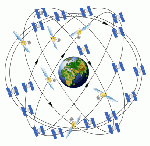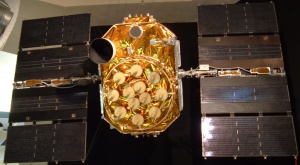If you wish to contribute or participate in the discussions about articles you are invited to contact the Editor
GPS Space Segment
| GPS | |
|---|---|
| Title | GPS Space Segment |
| Edited by | GMV |
| Level | Basic |
| Year of Publication | 2011 |
The main functions of the Space Segment are to transmit radio-navigation signals, and to store and retransmit the navigation message sent by the Control Segment. These transmissions are controlled by highly stable atomic clocks on board the satellites. [1]
The GPS Space Segment is formed by a satellite constellation with enough satellites to ensure that the users will have, at least, 4 simultaneous satellites in view from any point at the Earth surface at any time. The United States is committed to maintaining the availability of at least 24 operational GPS satellites, 95% of the time. To ensure this commitment, the Air Force has been flying around 30 operational GPS satellites for the past few years. [2]
GPS Satellite Constellation
The satellites in the GPS nominal constellation are arranged into in six equally-spaced orbital planes with an inclination of 55 degrees in relation to the equator. Each plane contains four “slots” occupied by baseline satellites. This 24-slot arrangement ensures users can view at least four satellites from virtually any point of the planet. [2]
The Air Force normally flies more than 24 GPS satellites to maintain coverage whenever the baseline satellites are serviced or decommissioned. The extra satellites may increase GPS performance but are not considered part of the core constellation.[2]
In June 2011, the Air Force successfully completed a GPS constellation expansion known as “Expandable 24” configuration. Three of the 24 slots were expanded, and six satellites were repositioned, so that three of the extra satellites became part of the constellation baseline. As a result, GPS now effectively operates as a 27-slot constellation with improved coverage in most parts of the world.[2]
Orbits are nearly circular, with eccentricity less than 0.02, a semi-major axis of 26 560 km, i.e. an altitude of 20 200 km. Orbits in this height are referred to as MEO – medium earth orbit. The satellites have a speed of 3.9 km per second and a nominal period of 12 h sidereal time (11 h 58m 2 s), repeating the geometry each sidereal day. The space segment is subject to maintenance and evolutions.
GPS Satellite Description
The design of GPS satellites has evolved with time. Each generation of satellites with similar characteristics is called a block. A brief description of the different GPS blocks follows:[1] [2]
Block I
- Block I, Navigation Development Satellites: Eleven satellites of this kind were launched between 1978 and 1985.[3] The Selective Availability (S/A) was not implemented. They weighed about 845Kg and had a planned average life of 4.5 years, although some of them lasted up to 10. They were capable of giving positioning service through L1 and L2 signals and for 3 or 4 days without any contact with the control centre.
Block II
- Block II and IIA, Operational Satellites: They consist of 28 satellites in total that were launched from 1989 to 1997 on and all of them have already been decommissioned (last one in 2019). They weighed about 1 500 Kg and had a planned average life of 7.5 years although the average life reached almost 26 years, more than 3 times over design lifetime.[4] Since 1990, an improved version was used, Block IIA (advanced), with capability of mutual communication. They were able to supply positioning service for 180 days with no contact with the control segment. However, under normal operating mode, they communicated daily. These satellites contained the Selective Availability capability.
- Block IIR, Replacement Operational SatellitesFrom 1997 to 2004, these satellites are being used as spares for Block II. Block IIR is formed by a set of 20 satellites, although it could be increased by 6 more. They weigh about 2 000Kg, included Rubidium Clocks and have a planned average lifespan of 10 years although the average lifetime has already reached the 18 years.[4] The main new functionality of these satellites is the implementation of AUTONAV capability, in which satellites can determine their orbits and compute their own navigation message autonomously. They have the capability to measure distances between themselves and transmit data to other satellites or to the control segment. A block IIR satellite must be capable of operating about half a year without any support from Control Segment without degradation in ephemeris accuracy.
- Block IIR-M, Modernized Satellites: These 8 satellites represent a modernized version of IIR family including a new military M code signals and the more robust civil signal L2C. They were launched from September 2005 to August 2009.
- Block IIF, Follow-on Operational Satellites: This block constitutes and improvement of block IIA based on the applicability of new technology and new improvements in the system, including the transmission of a third civil frequency L5 intended for Safety-of-Life applications and the provision of improved accuracy through advanced atomic clocks (2 radiation-hardened rubidium atomic clocks and 1 cesium clock with high stability timing). The first satellite (SVN62) was launched on May 28th 2010. Their theoretical average life is about 12 years although none of these satellites has reached its design life period to date.
Block III
- Block III: The new generation of GPS satellites introduces significant enhancements in navigation capabilities, by improving interoperability and jam resistance. They provide the fourth civil signal on L1 band (L1C). The first launch is expected as of 2017[5].
Finally, the following table gathers the main characteristics of a GPS Satellite:[6]
References
- ^ a b J. Sanz Subirana, JM. Juan Zornoza and M. Hernández-Pajares, Global Navigation Satellite Systems: Volume I: Fundamentals and Algorithms
- ^ a b c d e GPS Space Segment information in GPS official website
- ^ GPS Block I Information
- ^ a b GPS Positioning System Program Status (November 2019)
- ^ First GPS III Launch Slips to FY17, Inside GNSS, November 14, 2014
- ^ Global Positioning System Fact sheets


